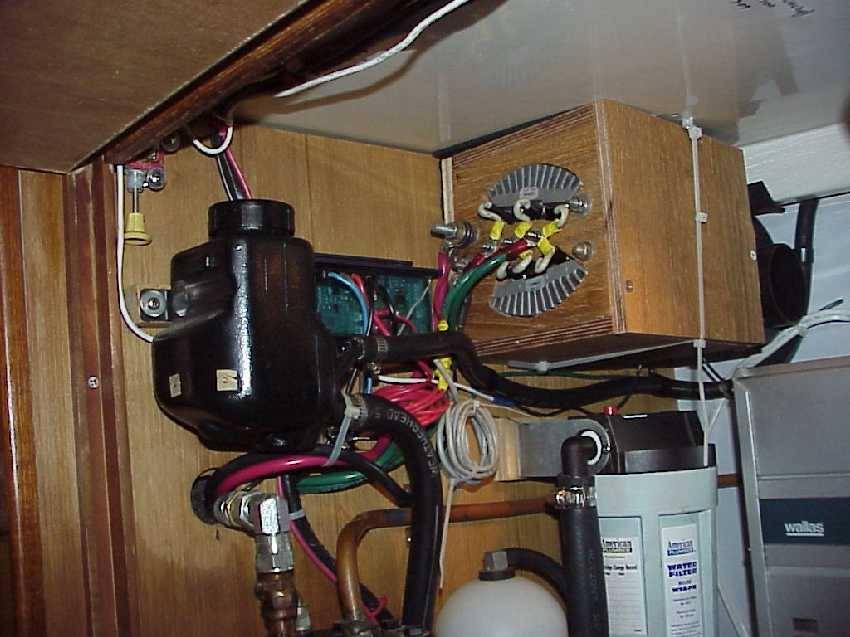
53.
11-12-4 That new box in the overhead of the equipment room needs explaining. During seatrials this summer in the wilds of Desolation Sound in British Columbia, we suffered TWO alternator rectifier failures. This is our fourth rectifier. The third and smaller model is a backup now.
The combination of the Balmar alternator and 3 stage regulator as it was PROGRAMMED, was too much for the rectifier when the battery charge was pulled down to 12.3 or so. The stock small size couldn't handle it and the solder between the diodes would melt. The first one died on day #2, before we cleared Customs at Bedwell Harbor. We made repairs at Pender Harbor. While we were waiting for parts, I rewired the alternator. I removed the rectifier and hung it in the location that the box now occupies. Three #10 wires were soldered to the stator and led back to the rectifier location. A Hella vent fan was aimed at the new rectifier and provided cooling. Off we went to Princess Louisa. The batteries were fully charged from the marina we were staying in while making repairs so we didn't have a proper test. The first morning at Princess Louisa, the new setup still couldn't handle the load and the replacement rectifier blew while I was LOOKING at it. Off we went to Westview, near Powell River. We pulled into the town dock and registered. I told the harbor master of our problem. He pointed to a guy getting out of his truck at the head of the dock. "That's the alternator repair man" he said. "That's all he does". We made contact and within two hours, his brother delivered a larger rectifier to our boat. The wiring was done already so it was just a bolt-in job. I also called Balmar for instructions as to how to re-program the regulator to a less severe setting. (I forgot the instruction manual at home) From that point on, everything worked great, but,,,, I wanted more.
When we returned home, I went to our local alternator shop and bought a MEGA/HUMONGOUS-rectifier. (The at-home price was $40.00. That's 50% less than the last one delivered to the boat) It comes in two pieces and has to be wired as shown. There is NO solder to fail. I replaced the #10 wire (adequate) with #8. That's the green wire seen in the photo. Remember, in the 'real alternator world', these wires don't exist. That means they must be built oversize to avoid detrimental heat buildup.
I built a box to mount the rectifier and to also mount a cooling fan. It's a Jabsco engine room blower, the black thing seen to the right of the box. The problem with it is it blows too hard. I slowed it to half speed with a switch seen in the upper left corner of the photo. It still puts out more air than needed but that is a good thing and I have the higher setting available with the switch if needed. The system wiring is easy. This is high school first-year autoshop stuff. This proves, once again, that removing systems from the hot engine room (It's power vented too) is a must.